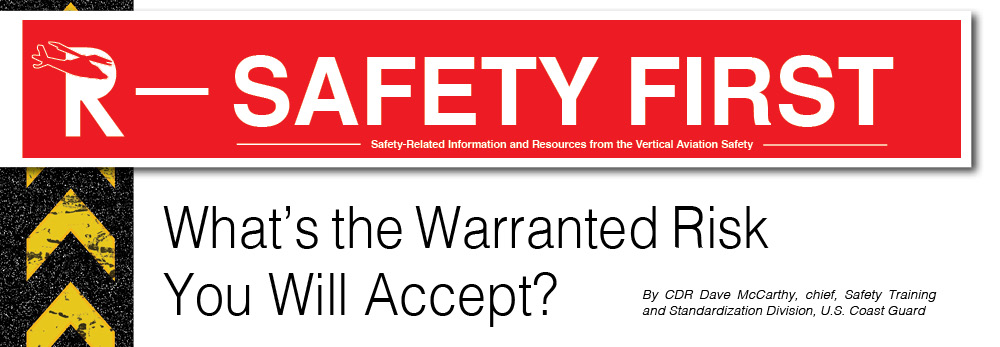|
Aug
14
2023
|
|
Posted 2 years 151 days ago ago by Admin
|
|

One dark night on the San Diego coast, my crew was launched for LE to intercept a drug-laden “panga” en route from Mexico to the U.S. We got the intel from our command center and launched into the blackness to find our panga. As we headed west over the Pacific Ocean with our radar scanning the surface of the water and our night vision goggles tuned up, we encountered declining ceilings at 1,000 feet AWL. We continued our search pattern at 700 feet and as the evening got cooler, the ceilings got lower. When we went down to 500 feet AWL, we discussed our hard deck of 200 feet AWL and termination of the search. We went down to 300 feet and finally at 200 feet we reached our limit and returned to base. The risk to my crew in declining ceilings was not worth the gain of finding the drug runner.
The U.S. Coast Guard, as a federal law enforcement agency, conducts aviation law enforcement missions enforcing U.S. law within our territorial waters as well as international laws abroad. We conduct aviation LE missions in conjunction with allied countries, including the Bahamas and Turks and Caicos in the Caribbean. We conduct shipboard LE missions on the high seas and land-based LE operations as well as national defense and ports, waterways, and coastal security missions. What risk should Coast Guard crews take to prosecute a mission? How much risk do you take with LE to accomplish the mission?
Warranted risk for missions involving general law enforcement and evidence recovery, as defined in the Coast Guard Operations Manual, CIM 3710.1 (series) states: “The possibility of recovering evidence and interdicting or apprehending alleged violators of federal law does not warrant probable damage to or abuse of the aircraft.” Contrast this to the risk for search and rescue and saving human life: “If a mission is likely to save human life, it warrants a maximum effort. When no suitable alternatives exist and the mission has a reasonable chance of success, the risk of damage to or abuse of the aircraft is acceptable, even though such damage or abuse may render the aircraft unrecoverable. Probable loss of the aircrew is not an acceptable risk.”
Does a minor overtorque during an LE mission mean that our aircrews are intentionally violating policy to prosecute a mission? It could mean that in order to maintain a proper safety margin the crew increased the collective and momentarily over torqued. In the safety world we are always trying to ensure that margins exist to ensure that our crews can return home to their families. If the overtorque is done with good intentions and not used to intentionally reduce the margin, the abuse is justified. A “just” safety culture is preserved when these unintentional errors are met with grace and ample opportunity to share the lessons-learned.
How does your agency limit or gauge risk? Do you have acceptable risks for various missions? Do your aircrews know how far to go in order to accomplish the tasked mission? As law enforcement agents, we Coasties want to valiantly uphold the laws, but we must do it in a prudent fashion. The potential loss of aircrew or damage to aircraft has been deemed as outside the risk tolerance for the general LE mission.
It may be difficult however to remain objective and unemotional when prosecuting an LE mission. As aviators, we must realize that the risk to our crew must always be weighed against the gain of the mission. Is the loss of an aircrew and aircraft acceptable to accomplish the mission? How about damage to the aircraft? These questions should be answered well in advance and the organizational culture should support and defend the warranted risk for LE missions.
READ MORE ROTOR PRO: https://justhelicopters.com/Magazine
WATCH ROTOR PRO YOUTUBE CHANNEL: https://buff.ly/3Md0T3y
You can also find us on
Instagram - https://www.instagram.com/rotorpro1
Facebook - https://www.facebook.com/rotorpro1
Twitter - https://twitter.com/justhelicopters
LinkedIn - https://www.linkedin.com/company/rotorpro1